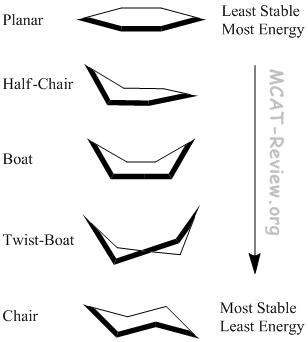- Electrophilic Addition to Unsaturated Carbons
A carbon—carbon double or triple bond undergoes an addition reaction bonding a new atom or group of atoms to each of the carbons of the original multiple bond. One of the groups that adds to the multiple (π) bond is an electrophile, the other is a nucleophile. As an addition to a carbon—carbon multiple bond proceeds, the electrophile adds to the less highly substituted carbon, and the nucleophile adds to the more highly substituted carbon. This direction of adding is called Markovnikov's rule.
Hydrogen halides add to the π bonds of alkenes and alkynes to form organohalogen compounds. In a polar-protic solvent this reaction proceeds through a carbocation. In a polar-aprotic solvent the reaction proceeds through an AdE3 mechanism.
An acid-catalyzed addition of water is an AdE2 reaction and proceeds via a carbocation.
The oxymercuration reaction proceeds through an AdE2 reaction via a cyclic mercurinium ion intermediate. Nucleophilic substitution by water followed by reduction with NaBH4 produces an alcohol with net anti addition. The reaction is both stereospecific and regiospecific.
Hydroboration is a stereospecific and regiospecific syn addition to an alkene forming an organoborane. The organoborane can be oxidized to form an alcohol. The alcohol is the anti-Markovnikov product.
Halogens add to alkenes to form vicinal dihalides. For bromine, the reaction proceeds stereospecifically via a three-membered ring bromonium ion. With chlorine, the reaction is less stereospecific. The reaction does not work well with iodine. In a water solvent, the water competes with the bromine nucleophile and reacts with the bromonium ion to form a halohydrin product.
Catalytic hydrogenation reduces a multiple bond by adding hydrogen to the π bond. Catalysts such as platinum, palladium, or nickel are the most common ones in use. Hydrogen adds to the multiple bond to form an alkane.
- Aliphatic Nucleophilic Substitution
An sp3 hybridized carbon undergoes nucleophilic substitution if it has a bond to an atom more electronegative than itself. Nucleophilic substitution at a saturated carbon atom follows one of two mechanisms. In the first mechanism, the leaving group departs before the nucleophile arrives. This is the SN1 mechanism. In the second mechanism, the leaving group departs as the nucleophile arrives. This is the SN2 mechanism. The rate for an SN1 mechanism depends only on the concentration of the substrate. Thus, an SN1 reaction follows first order kinetics and proceeds through a carbocation intermediate. The rate for an SN2 mechanism depends on the concentrations of both the nucleophile and the substrate. Thus, an SN2 reaction follows second order kinetics and is a concerted reaction. Because the SN1 mechanism has a symmetrical carbocation intermediate, it loses all stereochemical information in the reaction. The reaction proceeds with racemization of configuration. In the SN2 reaction, the nucleophile approaches from “behind” the leaving group resulting in an inversion of the configuration of the carbon in the substrate. In the inversion of configuration of the SN2 mechanism, the product has the opposite configuration of the starting material.
Nucleophiles and leaving groups are both bases. Usually, the leaving group is a weaker base than the nucleophile. Most good nucleophiles are soft bases. Reactions with both high solvent polarity and the ability of the solvent to solvate both the carbocation and the nucleophile promote SN1 reaction pathways. Low solvent polarity that does not stabilize carbocation formation promotes SN2 reaction pathways.
Halide nucleophiles react via either the SN1 or the SN2 mechanism depending on the substrate and reaction conditions.
Water and alcohols are good nucleophiles for solvolysis reactions. Their conjugate bases are good nucleophiles as well, but they tend to promote elimination reactions as side reactions to substitution reactions.








